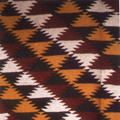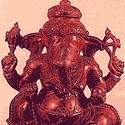
Dhurries, Floor Covering, Carpets, Textiles, Weaving, Spinning, Khadi
Cotton Panja Dhurries of Chandigarh
One can find cotton Panja durries influenced by the Bagh embroidery in Chandigarh.
Durries are flat and pile-less floor coverings common in Indian homes. Commonly they are made from cotton warp and jute, coir, wool and occasionally, unrefined silk weft. Different parts of the country have localised durrie traditions. These may be characterised by the particular combination of weaving technique, weft material, pattern stylisation, and motifs and colours used in different areas.
The Panja durrie is just one among the multitude of styles. In this a claw-like device, called Panja, is used by the weavers to densely pack the weft to almost hide the warp. The durries are made on simple horizontal looms in a weft-faced plain weave which gives it a sturdy, flat appearance.
A handloom weaver’s tribe called the Julaha tribe have been found to reside in Chandigarh. Due to the infiltration by the modern day techniques and machines their craft is dying out however some still continue to weave, to make coarse cloth for bedspread or kharad and durries.
Gallery
YOUR VIEWS
PRACTITIONERS: INDIA
Access 70,000+ practitioners in 2500+ crafts across India.
BIBLIOGRAPHY
10,000+ listings on arts, crafts, design, heritage, culture etc.
GLOSSARY
Rich and often unfamiliar vocabulary of crafts and textiles.
SHOP at India InCH
Needs to be written.





